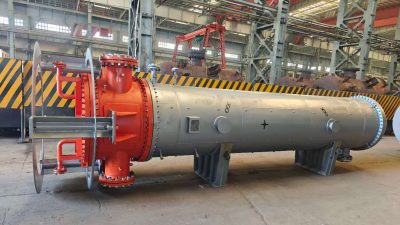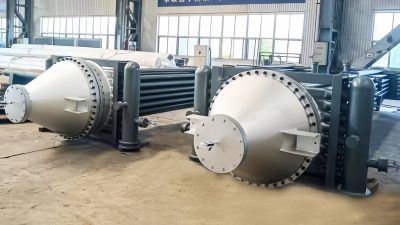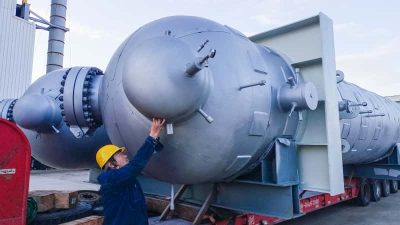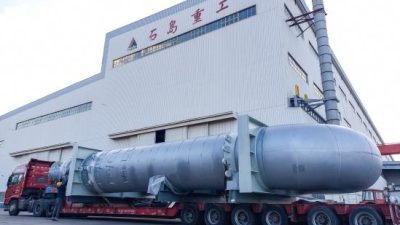Send Email
Call / WhatsApp Anytime
Send Email
Call / WhatsApp Anytime
A Breech Lock Type Heat Exchanger is a specialized shell-and-tube heat exchanger designed to operate under high pressure and high temperature conditions. It uses a bayonet-style breech lock closure system instead of conventional bolted flanges. This design allows quick and safe access to the tube bundle for maintenance or inspection without dismantling the entire piping system.
The Weihai Shidao Breech Lock Type Heat Exchanger is a high-performance pressure vessel designed for critical process applications requiring rapid access, minimal maintenance downtime, and robust pressure containment. Manufactured by Weihai Shidao Heavy Industry Co., Ltd., this exchanger combines engineering precision, advanced metallurgy, and ASME-compliant fabrication to meet the stringent demands of oil & gas, petrochemical, and power generation industries.




Certified Safety, Reliable Quality, Custom-Engineered Pressure Vessels.
— Globally Compliant, Built for Harsh Industrial Conditions.
The Breech Lock Type Heat Exchanger is a high-performance shell-and-tube heat exchanger designed for critical process conditions involving high pressure, high temperature, and corrosive media. Its bayonet-style quick-opening closure system allows for rapid maintenance access without disconnecting process piping, making it highly suitable for applications where operational continuity, personnel safety, and inspection frequency are of utmost importance. Due to its superior sealing integrity, structural strength, and ease of service, it is widely adopted across oil & gas, petrochemical, refining, fertilizer, chemical, hydrogen, and power generation sectors.
| Industry | Application Scenarios | Key Benefits of Breech Lock Design |
|---|---|---|
| Oil & Gas | – Amine gas treating units (CO₂ & H₂S removal) – Natural gas dehydration and compression – Offshore platforms and FPSOs – Gas sweetening and NGL recovery | – Quick access for fouling removal – Ideal for sour service & cyclic loading – No need to remove connected piping |
| Petrochemical | – Steam reforming (hydrogen plants) – Ethylene and propylene recovery – Syngas cooling and conditioning – Aromatics extraction systems | – Handles thermal cycling well – Fast tube bundle access during shutdowns – Resistant to high-temp corrosive gases |
| Refining | – Hydrocracking and desulfurization units – Catalytic reforming and hot oil trains – Vacuum distillation overhead cooling – Crude preheat exchangers | – Suitable for extreme pressure & temp – Efficient thermal transfer – Fast opening for decoking or inspection |
| Fertilizer & Chemical | – Ammonia and urea synthesis loops – Carbamate condensers – Nitric and phosphoric acid units – Methanol and formaldehyde production | – Excellent in corrosive and acidic media – Durable under high-pressure synthesis – Minimizes unplanned shutdowns |
| Hydrogen & Syngas | – Hydrogen reformer effluent coolers – Water-gas shift reactors – Blue hydrogen/CCUS plants – Methanol, ammonia, and syngas loop conditioning | – Resistant to hydrogen embrittlement – Maintains purity and process uptime – Safe maintenance under pressurized environments |
| Power Generation | – Feedwater heaters and economizers – Boiler blowdown heat recovery – High-pressure condensate cooling – Steam turbine interchangers and reheaters | – Suited for thermal cycling and scale buildup – Low maintenance frequency – Easy access in confined spaces |
As a leading pressure vessel and heat exchanger manufacturer, Weihai Shidao Heavy Industry Co., Ltd. specializes in the design and fabrication of Breech Lock Type Heat Exchangers for complex industrial processes. With ASME, PED, and ISO certifications, and decades of experience serving global oil & gas, petrochemical, chemical, and power sectors, Weihai Shidao provides fully customized heat exchange solutions tailored to customer process requirements. The company integrates advanced CAD/CAE engineering, full material traceability, and rigorous non-destructive testing (NDE) to ensure every exchanger meets international safety and performance standards. Whether used in Middle East gas processing plants, Asian petrochemical complexes, or African hydrogen reformers, Weihai Shidao’s Breech Lock Heat Exchangers deliver superior sealing, faster maintenance, and long-term reliability in the world’s most demanding environments.
A breech lock heat exchanger is a shell-and-tube exchanger that uses a bayonet-style quick-opening closure system instead of standard flanged bolted connections, allowing faster and safer access to the tube bundle without removing process piping.
A breech lock type heat exchanger is a shell-and-tube heat exchanger specifically designed for high-pressure and high-temperature applications. It performs thermal energy exchange between two fluids—just like a traditional exchanger—but its standout feature is the breech lock closure system, which replaces standard bolted flanges for faster, safer maintenance access.
Shell-side fluid flows around a bundle of tubes inside the shell.
Tube-side fluid flows inside the tubes.
The two fluids are separated by tube walls, and heat is transferred through conduction and convection, without mixing the fluids.
Flow configurations can be single-pass or multi-pass, counter-flow or parallel-flow, depending on process design.
The breech lock mechanism is a bayonet-style quick-opening design typically used on the channel (head) end of the heat exchanger. This closure allows rapid removal of the channel cover and tube bundle without disconnecting piping, making it ideal for frequent maintenance and inspection.
A locking ring or segment with bayonet-style teeth rotates to engage/disengage from lugs on the shell or channel cover.
Once unlocked, the channel cover can be pulled or slid away using guide rails or a trolley system.
The tube bundle can then be extracted from the shell if needed for cleaning or inspection.
Sealing is typically achieved with a metal-to-metal surface plus O-ring or graphite gasket, ensuring leak-tight performance even under extreme pressure.
Operation: Fluids enter and exit through inlet/outlet nozzles. Heat is exchanged as they flow through shell-side and tube-side paths.
Maintenance Preparation: After depressurizing and cooling, the safety lock is released.
Opening: Rotate the locking ring to disengage, and slide the cover open.
Inspection/Service: Tube bundle can be removed and serviced on-site without removing adjacent piping.
Closing: Align the cover, rotate the lock ring, seal compresses tightly, and system is pressurized again.
Fast opening/closing – often under 30 minutes
No need to dismantle piping
Improved worker safety during access
Less risk of leakage under cyclic loads
Ideal for high-maintenance processes
Sour gas systems (CO₂, H₂S)
High-pressure hydrogen or ammonia loops
Heat exchangers subject to fouling or corrosion
Applications requiring frequent inspection or cleaning
Breech lock type heat exchangers are specifically engineered for demanding service conditions, and their design ranges vary based on material selection, industry standards (e.g., ASME, PED), and application requirements.
| Parameter | Typical Range |
|---|---|
| Design Pressure | 10 bar to 700 bar (145 psi to 10,000 psi) |
| Design Temperature | -50°C to 600°C (or -58°F to 1112°F) |
With advanced materials (e.g., Inconel, Hastelloy, titanium), and appropriate sealing, exchangers can handle:
Pressure: Up to 1000 bar (14,500 psi) in niche applications (e.g., hydrogen, ammonia loops)
Temperature: Up to 650–700°C for special metallurgy and reformer duty
Shell and tube material (carbon steel, stainless steel, duplex, Incoloy, etc.)
Sealing system (metallic vs. elastomeric)
Operating fluid properties (corrosiveness, phase, pressure drop)
Compliance codes (ASME VIII Div.1/2, PED, TEMA Class R)
Hydrogen reformers: ~500–600°C, 100–300 bar
Amine units: ~120–180°C, 10–30 bar
Urea loops: ~180–210°C, 150–250 bar
Power plant feedwater heaters: ~250–350°C, 100–200 bar
Would you like a visual chart comparing pressure/temperature ranges across different industries or fluid types? I can also help provide ASME design margin notes or help interpret specific datasheets.
While all Breech Lock Type Heat Exchangers share the same core feature—a bayonet-style quick-opening closure system—they can be classified into various types based on tube bundle configuration, flow path, installation orientation, and application-specific design. Below is a professional classification:
Fixed Tube Sheet Type
The tube bundle is permanently attached to the shell; used when the thermal expansion between shell and tubes is minimal. Ideal for clean and non-corrosive fluids.
U-Tube Type
Tubes are bent into a U-shape and free to expand, making them suitable for high temperature differentials. Common in steam heating or thermal cycling systems.
Floating Head Type
Allows both ends of the tube bundle to move independently; ideal for handling fouling or when tube-side fluids require frequent cleaning. Often used with breech lock closures on the channel end.
Single-Pass Design
The fluid flows once through the tube bundle—simpler design, lower pressure drop, easier maintenance.
Multi-Pass Design
Incorporates baffles and partition plates to route the fluid through multiple passes—enhances heat transfer efficiency, suitable for compact high-duty exchangers.
Counter-Flow / Parallel Flow
Orientation of hot and cold streams can be arranged to optimize thermal performance based on process needs.
Horizontal Breech Lock Heat Exchanger
Most common design, easy to install and maintain in refineries, chemical plants, and gas facilities.
Vertical Breech Lock Heat Exchanger
Used when footprint is limited or for natural gravity-driven processes (e.g., condensers, reboilers). Requires vertical bundle handling.
Reboilers (Thermosiphon or Forced Circulation)
Used in distillation systems with vapor-liquid phase separation.
Condensers / Coolers
For vapor condensing or gas/liquid cooling applications in power and chemical systems.
Feed/Effluent Heat Exchangers
Heat recovery units where hot product stream pre-heats incoming feedstock, common in reforming and hydroprocessing.
ASME Section VIII Division 1 or 2 Design
For pressure vessels following American standards.
TEMA Type (E, F, G, etc.)
Based on shell-tube-channel configuration:
Type BEM: Fixed tube sheet, removable channel
Type AES: Floating head with removable cover and bundle
Type AET: Pull-through floating head (common with breech lock)
| Classification | Options |
|---|---|
| Tube Bundle Type | Fixed tube sheet, U-tube, Floating head |
| Flow Configuration | Single-pass, Multi-pass, Counter-flow, Parallel-flow |
| Mounting Orientation | Horizontal, Vertical |
| Functional Use | Reboiler, Condenser, Cooler, Feed-Effluent Exchanger |
| Design Standard | ASME VIII Div.1/2, TEMA (e.g., AES, AET, BEM), PED, GB |
The price of a breech lock type heat exchanger can vary widely depending on several technical and project-specific factors. These units are custom-engineered, and therefore pricing is typically provided on request (RFQ) after receiving the process design data.
| Capacity / Size | Estimated Price Range (USD) |
|---|---|
| Small lab-scale (5–10 m²) | $10,000 – $25,000 |
| Medium duty (20–50 m²) | $40,000 – $90,000 |
| Large industrial (50–200 m²) | $100,000 – $300,000+ |
| High-pressure hydrogen/ammonia use | $200,000 – $500,000+ (special alloys, ASME) |
⚠️ Note: These are budgetary estimates only. Actual pricing may vary based on specifications, standards, location, and materials.
Design Pressure & Temperature
Higher pressure (e.g., 150–600 bar) and high-temperature (400–600°C) applications require thicker shells, stronger closures, and premium materials.
Material of Construction
Carbon steel (cheaper)
SS304/316L (medium)
Duplex, Inconel, Hastelloy, Titanium (expensive)
Heat Transfer Area & Tube Count
The larger the surface area (measured in m² or ft²), the more tubes and longer shells are needed.
Closure Mechanism Complexity
Breech lock systems are more complex than standard flanged types, requiring precision machining and custom fabrication.
Compliance Standards
ASME U Stamp, PED, TEMA R, and special NDE (e.g., RT, PMI, Helium leak test) increase inspection and documentation costs.
Delivery Location & Logistics
Ocean freight, local duties, and installation support can significantly impact total cost.
Optional Accessories
Tube bundle handling system (rails, carts)
Skid-mounting or integration with piping
Thermal insulation and painting
Remote monitoring systems
A 100 m² breech lock exchanger for hydrogen service, designed to ASME VIII Div.2 with Inconel-clad tubes, may cost $250,000–$400,000.
A 20 m² SS316L unit for refinery amine system, designed to TEMA R standard, may cost $50,000–$80,000.
To get an accurate price, prepare a basic specification or inquiry sheet with:
Would you like a downloadable RFQ template, or need help drafting an inquiry form to suppliers like Weihai Shidao? I can help create that for you.
Ready to optimize your thermal systems with industry-proven heat exchange solutions?
Contact WSHI today to discuss your application needs. Whether you’re operating in petrochemical, power generation, chemical processing, or next-gen energy sectors, our engineering team will deliver tailored heat exchanger systems built for performance, reliability, and efficiency.
📩 Get in touch now for technical consultation, custom design support, or a detailed quotation.
Let’s engineer the future of energy efficiency—together.